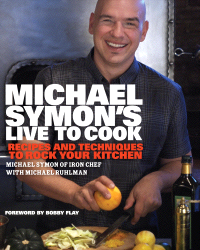There is something very familiar about Michael Symon’s Live to Cook: Recipes and Techniques to Rock Your Kitchen (Clarkson Potter 2009) written with fellow Cleveland native Michael Ruhlman. It may be that it resembles many other cookbooks from Food Network celebrities in size and look. There are plenty of pictures of Michael Symon in T-shirts, with his dogs, grinning for the camera.
 The photos may have something to do with the tone of the book. It is heavy on “family” and approachable, easy-to-make-at-home food, although there are many recipes with unusual ingredients, including offal. Michael’s food is heavy on pork and spice from the many countries where his parents have roots – Greece, Italy and Slovakia, and the local dishes of Cleveland.
The photos may have something to do with the tone of the book. It is heavy on “family” and approachable, easy-to-make-at-home food, although there are many recipes with unusual ingredients, including offal. Michael’s food is heavy on pork and spice from the many countries where his parents have roots – Greece, Italy and Slovakia, and the local dishes of Cleveland.
Yet, it would be wrong to dismiss this book. It does have some original thinking and some very good recipes. Start with the organization of the book. It is very Italian, with sections on Pasta, Gnocchi, and Risotto (p. 81) followed by Charcuterie (p. 91) and then a wonderful chapter on Pickles (p. 115) and finally Stocks Sauces and Condiments (p. 125) – all before you get to any meat. It is as if the book were encouraging you to learn basics first, before you tackle tougher or more complex dishes. There are even some recipes tucked into Michael’s introduction – Keftedes (Mom’s Little Meatballs) (pp. 11-12), flavorful meatballs you might find in a taverna in Greece.
In the Starters chapter, pork makes a powerful play with Crispy Pig’s Ears with Pickled Vegetables (pp. 38-39). There are helpful hints sprinkled throughout the book, under Symon Says as well as essays on Michael’s career, like Starting Out (p. 37) and food topics, like The Power of the Pierogi (p.p. 42-43). These give insight into who Michael is as a chef, and how he became successful.
The Pickles chapter is at the heart of the book, a lesson on balancing flavor:
If there is a single element of flavor that I think cooks need to focus on when they’re working to improve their food, it’s acidity. Controlling the level of acidity in your dishes is one of the most important skills you can develop; often a simple squeeze of lemon juice is all a dish needs to go from good to great. (p. 115)
Michael has expanded the simple squeeze of lemon that makes a Mediterranean lentil or chicken soup taste so good, and the wonderful pickles of Eastern Europe and the Balkans, into a way of enhancing flavor. Learning how to balance flavor is learning how to make a dish taste good.
The chapter is full of fine pickle recipes like Master Pickling Recipe Using Onion (p.117) and an unusual Pickle Cherries (p. 119) for rich dishes like duck. As for the duck dish, Confited Duck with Pickled Cherry Sauce and Braised Endive (p. 223) is a rich dish assembled from recipes spread throughout the book. It is successful because of the balance the pickled cherries bring to the dish. A recipe for Pickled Green Tomatoes (p. 122) is matched with Braised Short Ribs (p. 212) to cut the rich meat.
If you are a fan of Iron Chef America, you’ll want to get Michael Symon’s Live to Cook. But even if you aren’t a fan, the book is a fine collection of imaginative recipes constructed around flavor.
RECIPE: Pickled Cherries
Makes about 2 quarts
Ingredients:
2 pounds bing cherries
2 cups red wine vinegar
1 1/2 cups sugar
2 tablespoons kosher salt
2 strips orange zest, removed with a vegetable peeler
1 tablespoon black peppercorns
2 cinnamon sticks
1 tablespoon coriander seeds
1 bay leafInstructions:
Prick each cherry with a fork several times and put them in a nonreactive jar or container.
Mix the vinegar, sugar, salt, orange zest, black peppercorns, cinnamon sticks, coriander seeds, and bay leaf in a nonreactive saucepan and bring to a boil. Reduce the heat so the liquid simmer, and cook for 10 minutes. Remove from the heat and let cook for 10 minutes.
Pour the liquid over the cherries (they should be completely submerged). When the concoction is completely cool, seal or cover the cherries, and refrigerate for up to 1 month.(From Michael Symon’s Live to Cook)
